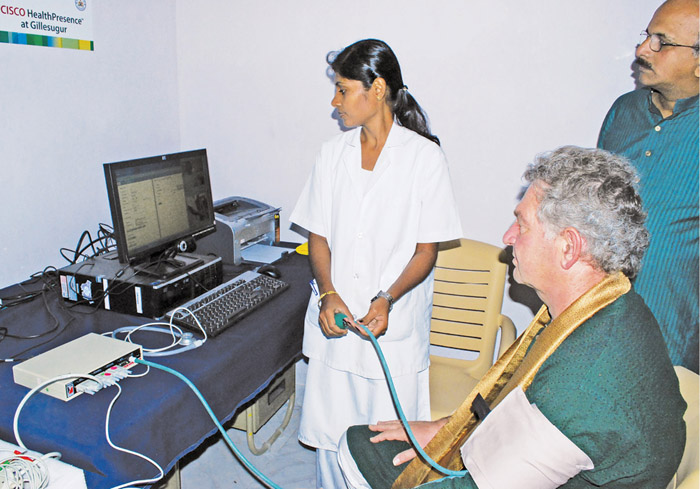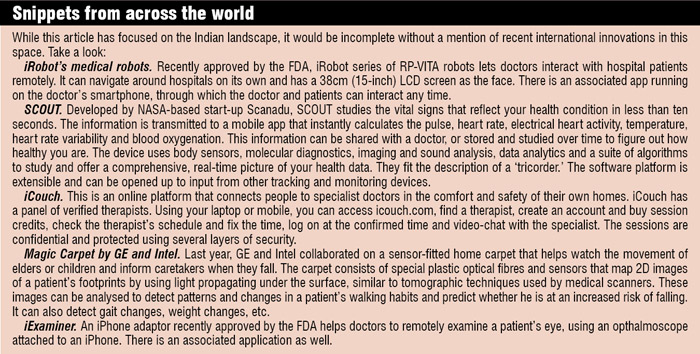A recent report titled ‘Foreseeing the Future of Healthcare’ by Wipro and Dun & Bradstreet India revealed that while 70 per cent of India’s population resides in rural areas, only one-fourth of the country’s specialist physicians live in semi-urban areas, and even less than 5 per cent of them reside in rural areas. In the present scenario, remote delivery of medical advice along with diagnostic and healthcare services seems to be the best way to treat people living in villages. Here we are not talking about robot-doctors and tricorders but practical, low-bandwidth telemedicine and health monitoring technologies that will help the masses in India.
“On an average, India has one doctor for every 1700 people, while the optimal average should be one doctor for every 600 citizens. In some cases, the ratio is up to one doctor for every 25,000 citizens. The United States has one doctor for every 350 citizens, and if India aspires to become a superpower, it needs to increase the number of doctors by six times. This is impossible as no country can organically grow their medical population six times quickly and meet the quality. This is where telemedicine technology comes in the picture,” says Vishal Gupta, vice president-Global Healthcare Solutions Unit, Cisco.

“Telemedicine can virtually deliver a doctor, specialist or super-specialist to a patient in a remote area through networking technology. In the case of Cisco’s technology, the interaction between them is through video using a vernacular language. The doctor can read and see all the vital tests that are done on a patient. The patient can interact with the doctor as if the doctor is present in the same room. Finally, the doctor can dispense a prescription or recommend a course of treatment that can be taken by the patient just as he would do in a real-life situation. This fundamentally balances out the doctor-citizen imbalance we see in India as well as the urban-rural divide in terms of resource availability,” he adds.
Telemedicine and health monitoring technologies have been around in India for over a decade, and have been growing slowly and steadily. However, in recent times, several factors have boosted the growth of this sector. First of all, developments in the field of electronics, especially micro-electromechanical systems (MEMS) and system-on-chip (SoC) technologies, have vastly improved the size, quality and precision of medical equipment. Wireless technologies have enabled remote delivery of services. Information technology, especially the cloud, has improved the ways in which medical information is shared, stored and processed. The mobile phone, its services and apps have brought telemedicine and health monitoring to the masses—literally. In fact, the use of the mobile for keeping track of vital signs, analysing information collected by medical equipment, communicating health status to doctors and receiving advice from them has expanded the scope of telemedicine and health monitoring.
From being used only for delivering medical services remotely to rural areas initially, these technologies are now also being used to provide better services to patients in hospitals, take care of specially-challenged or aged people, monitor foetal health and even improve the fitness level of people.
Let us take a look at the key components of telemedicine, as well as recent innovations and some promising technologies and products in this space.
What’s inside?
There is a wide array of telemedicine and health monitoring equipment available today. Broadly, we can divide them into diagnostic and therapeutic equipment like electrocardiographs and pacemakers, imaging technologies like X-ray and magnetic resonance imaging (MRI), medical instruments like blood analysis systems and dialysis systems, patient monitoring and consumer products like remote monitoring tools, insulin pumps and heart-rate monitors, as well as wellness equipment like pedometers and cardio trainers.

Such equipment can be thought of as having a layer of information and communication technology (ICT) atop a medical device. These usually comprise a combination of sensors, MEMS, low-power high-performance microcontrollers, wireless modules, signal conditioners, analogue-to-digital converters, etc, which work alongside user-friendly but powerful software. The infrastructure required includes uninterruptible power supply and Internet—both of which are a challenge in the Indian landscape.
“With increasing penetration of mobile infrastructure into the remote areas, mobility is expected to play a larger role in healthcare as well. Solutions will have to be designed to be mobile, as we go along. 3.5G and 4G are going to have a huge impact on the ability to deliver healthcare at the patients’ doorsteps. However, until the connectivity reaches rural areas, the impact will be seen only on the urban population and the changes will miss the vast majority of the population that lives in the rural areas,” remarks Rajeev Kumar, founder director, Neurosynaptic Communications—a company that has made a mark in the Indian telemedicine arena with its ReMeDi solution.






